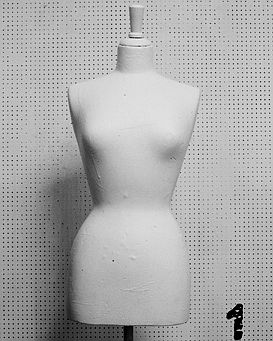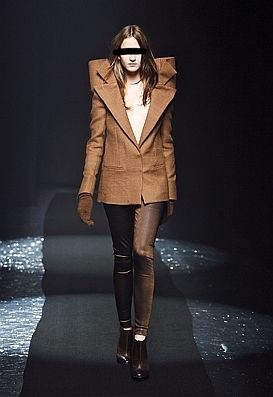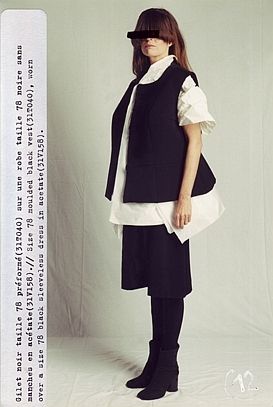"Maison Martin Margiela 20" @ Haus der Kunst, Munich
Martin Margiela, Autumn / Winter 1996–1997. Photo: Ronald Stoops
MUNICH.-Haus der Kunst presents today Maison Martin Margiela 20. The exhibition, on view through June 1, 2009. Following his studies at the Antwerp Academy and his work as an assistant to Jean-Paul Gaultier, the Belgian Martin Margiela founded Maison Martin Margiela in 1988. The firm’s 20th anniversary is the reason for this exhibition. Maison Martin Margiela is based in Paris and designs fashion that rebels against the industry’s constraints while also commenting on these.
Since Coco Chanel and Yves Saint Laurent, there has hardly been a fashion designer, who was similarly influential. Even colleagues appreciate Maison Martin Margiela’s importance. "Everyone is influenced by Comme des Garçons and by Martin Margiela. Anybody who’s aware of what life is in a contemporary world is influenced by those designers", Marc Jacobs explains in ’Women’s Wear Daily’.
Incognito Maison Martin Margiela’s (MMM) approach differs in many ways from what is usual in the fashion trade. Rather than engaging in the personality cult like other fashion houses, MMM functions according to the principal of incognito: In order to focus the attention solely on the company’s products, Martin Margiela does not even appear in public at fashion shows and does not publish his portrait. MMM gives interviews in the first person plural either by e-mail or fax. It is unusual and uncompromising to remain incognito in a field in which many fashion designers behave like stars whose personal appearances provide almost as much as an incentive to buy as their creations. At MMM it is not the designer who is in the spotlight but the product.
Normally a fashion house’s label guarantees the authenticity of its products. MMM’s label, however, contains no writing or logo; it is a simple white rectangle, sewn on with white thread and four corner stitches to the inside of the garment. In the figurative sense, one could say that MMM does not ’sign’ his products.
Even at defilés MMM guides the viewer’s attraction solely to the product. The presentation of new collections are not held in glamorous locations, but on the playing fields of football stadiums or in railway carriages and bars, where other members of the public are also present.
Today the faces of famous models such as Kate Moss constitute a kind of public property that has little right to privacy. MMM, in contrast, preserves and protects the identity of its models – by means of long ponytail hairpieces, pantyhose veils or, in catalogues, with black bars behind which the models’ eyes remain invisible. A pair of sunglasses from the 2008 spring/summer collection is shaped like such a bar and is tellingly named ’Incognito’. Nowadays MMM works with professional models. In the early days, however, models were chosen in street castings; charisma and personality were the decisive criteria rather than the common standard of beauty. At MMM it is not the models that have the status of icons, but rather the tools of the tailors and dressmakers: scissors, clothes hangers, dressmaker’s dummies, shoe lasts and shoetrees.
Transience and Fragility Ageing and decay are commonly considered a taboo in the fashion industry. MMM, however, does not conceal the traces of wear that a garment may acquire over time, but rather draws attention to them. White paint, which covers many of MMM’s products, plays a central role in this respect. When worn, the white paint on these garments gradually cracks; the actual texture and sometimes another colour underneath becomes visible.
These individual marks are what make the piece of clothing unique.
When MMM moves into new spaces, it takes over the furnishings of the previous inhabitants and paints them white. The paint is often applied with coarse brushstrokes and conveys the impression that a certain moment in the past is frozen in time: "White means the strength of fragility and the fragility of the passage of time". (MMM 2008)
The use of certain materials also refers to the passage of time. Used materials as silent witnesses of past times allow for the creation of new products: woollen military socks are transformed into a sweater, a waistcoat is made out of porcelain shards and plastic bags are made into T-shirts. When Martin Margiela presented such products to the public at the end of the 1980s it was considered utterly outrageous on the Paris catwalks.
Since fall/winter of 2005-2006 MMM also produces an artisan line: unique items fabricated with the same labour-intensive manufacture as in haute couture. The term luxury, however, undergoes a semantic shift in the MMM collection. It does not signify the high value of the materials used, but rather the number of hours invested in the production of such unique garments. The low value of the second-hand materials used is contrasted with the number of production hours: 55 hours are needed to create a fox stole made of paper balls that can be used like confetti at parties; 45 hours are required to make a backless top out of the reflecting facets of a disco ball. According to Karl Marx, the consumer is alienated from the product he produces when the amount of time required to create it is no longer visible. By intentionally making the production time visible, MMM holds out the prospect that this could actually abolish the Marxist theory of consumer alienation from the product.
MMM garments also expose the tricks tailors use. Rather than concealing the traces of design and production, these are, in fact, emphasised. Things usually found on the inside of a garment are turned inside out to create the outside: shoulder pads and linings, stitches with white basting thread, darts, hems and backstitched seams.
Opposition to the Standardised Body Margiela loves to play with human dimensions. Articles from the fall/winter collection 1994-1995 were based on toy dolls’ wardrobes, as originally produced for Ken and Barbie or GI Joe, and then enlarged to human dimensions by MMM. The starting point for these was the standardised body – because toy dolls served as a miniature version of the ideal adult body image. Yet when enlarged to human scale, a multitude of discrepancies and disproportions become visible. To actually produce snap fasteners and zippers in the minuteness appropriate for dolls is too elaborate a process. When enlarged to human dimensions by MMM, they appear almost monstrous. Detailed finishes are often lacking in dolls’ clothing in order to keep production costs as low as possible: surpluses of thread are not cut off; seams on collars or backs of garments are not fully stitched together. In MMM’s collection these deliberately used stylistic devices appear both comical and disquieting.
Conversely, it was only logical when, in 2001, MMM introduced a spring collection for women that featured oversized clothing based on the Italian sizes 78 and 80. Because of the material’s volume, these extremely oversized items demand a different body posture and slower tempo from their wearers; by virtue of this they demand additional awareness.
Between Trash and Fairy Tales Since the combination of classical tailoring and dressmaking couture and conceptual thinking is so exceptional, MMM’s products are occasionally mistaken for anti-fashion; they are, however, far more a commentary on the fashion industry. MMM employs the practices of haute couture in order to confront the constraints of the industry with humour.
By incorporating transience and fragility, MMM’s creations "oscillate between trash and fairy tales" (Barbara Vinken) and refuse the fetishisation of the ideal body. The fact that Maison Martin Margiela ventures to the limits of outward unsightliness constitutes its inimitability and esprit.
The retrospective is arranged in sections, such as tabis (ankle boots, with a separate sole for the large toes); replica (reproductions of archetypical second-hand clothing from different eras); down coats; ’flat’, two-dimensional designs; men’s line; trompe l’oeil; dolls’ clothing; oversizes; artisan; offices and shops.
The exhibition was created in collaboration with the MoMu – Fashion Museum in Antwerp, where it was on view from 12th September 2008 to 8th February 2009, and Maison Martin Margiela, Paris. The scenography was designed by Bob Verhelst. An exhibition catalogue is published in English, ’Maison Martin Margiela 20. The exhibition’, published by MoMu – Fashion Museum, Antwerp; 2008, ISBN 9 789 079 269 006, 120 pages; with contributions by Kaat Debo and Barbara Vinken.
On Thursday, March 19th at 6.30 pm the first store of MMM in Germany opened at Maximilianstrasse 34, 80539 Munich.
Martin Margiela, Autumn / Winter 2005–2006. Photo: Marina Faust
Martin Margiela, Icône 1 recto. Photo: Marina Faust
Martin Margiela, Autumn / Winter 2008-2009. Photo: Giovanni Giannoni
Martin Margiela, 4 points blanc. Photo: Julien Oppenheim
Martin Margiela, Autumn / Winter 2000–2001. Photo: Jacques Habbah
Martin Margiela, Icône 1. Photo: Marina Faust

/https%3A%2F%2Fprofilepics.canalblog.com%2Fprofilepics%2F1%2F0%2F100183.jpg)
/https%3A%2F%2Fstorage.canalblog.com%2F03%2F02%2F119589%2F96711876_o.jpg)
/https%3A%2F%2Fstorage.canalblog.com%2F11%2F31%2F119589%2F94773502_o.jpg)
/https%3A%2F%2Fstorage.canalblog.com%2F20%2F83%2F119589%2F94772815_o.jpg)
/https%3A%2F%2Fstorage.canalblog.com%2F26%2F72%2F119589%2F75604929_o.jpg)
/https%3A%2F%2Fstorage.canalblog.com%2F59%2F60%2F119589%2F26458628_o.jpg)









/http%3A%2F%2Fstorage.canalblog.com%2F62%2F17%2F119589%2F94174289_o.jpg)
/http%3A%2F%2Fstorage.canalblog.com%2F39%2F26%2F119589%2F35147007_o.jpg)
/http%3A%2F%2Fstorage.canalblog.com%2F43%2F36%2F119589%2F32110381_o.jpg)
/http%3A%2F%2Fstorage.canalblog.com%2F60%2F09%2F119589%2F30724351_o.jpg)